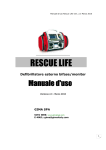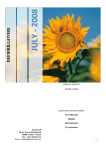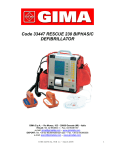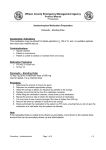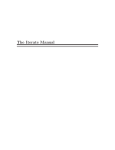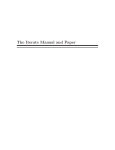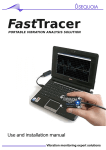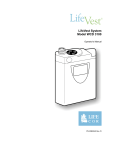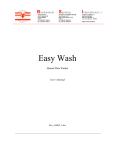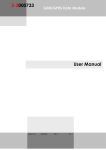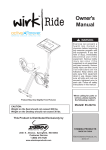Download Rescue Life UserMan v2.3 March 2010 GIMA_EN
Transcript
Rescue Life User Manual vers. 2.3 March 2010 RESCUE LIFE External Biphasic Defibrillator/monitor Use r M a n u a l Version 2.3, March 2010 GIMA SPA WEB-SITE: www.gimaitaly.com E-MAIL: [email protected] 1 Rescue Life User Manual vers. 2.3 March 2010 INDEX Safety Instructions Page 3 Introduction Page 5 Warranty Page 6 Service Page 7 How to use this manual Page 8 Electrical safety guidelines Page 8 Device operation and storage guidelines Page 9 Cleaning and maintenance Page 10 Product description Page 11 Intended use Page 12 Indications Page 12 Contraindications Page 12 Intended users Page 12 Operational controls and indicators Page 13 Front panel keys Page 14 Function keys (F1-F5) Page 15 Light indicators Page 15 Start screen Page 16 Operational screen Page 17 Start-up menu Page 18 Operational screen guide Page 19 Input ports, printer Page 20 Input Connectors Page 20 Device preparation Page 21 Product check Page 21 How to test the defibrillator Page 21 Patient preparation Page 21 ECG patient cable connection and electrodes placement Page 22 Defibrillation procedure in manual or advisory (ADV) Mode Page 23 Semiautomatic AED mode Page 24 Printing and paper change Page 25 Battery charge Page 26 Data/time setup Page 26 PACEMAKER (optional) Page 27 AED semiautomatic operation (optional) Page 28 Semiautomatic (AED) mode flow chart Page 30 Data Base Page 31 Data Base Screen Page 32 Appendix A – Biphasic defibrillation Page 33 Appendix B – Accessories Page 39 Appendix C – Technical Specifications Page 40 Technical Features Page 42 APPENDIX D- CE declaration of conformity Page 43 APPENDIX E- Warranty Certificate Page 44 2 Rescue Life User Manual vers. 2.3 March 2010 SAFETY INSTRUCTIONS GENERAL - Assure yourself prior and after the use of the RESCUE LIFE that the unit is in safe and usable condition (cables integrity, pads, battery status). - Assure that the battery charge , ECG trace, selected energy value, SYNC mode and status battery are well functioning. - RESCUE LIFE is not intended for use in areas of highly inflammable anesthetics or other inflammable substances, especially in high concentration of oxygen areas. - RESCUE LIFE does not have to be put or used nearby a nuclear spin tomography plant, which is turned on. DEFIBRILLATOR - Never put in contact the defibrillator paddles (short circuit). - Defibrillation in manual mode must be performed only by highly trained medical personnel. - Be sure that both surfaces of the shock paddles are completely moistened with gel. - The shock paddles must be held at distance from other electrodes and any metal parts in contact with the patient. - The patient must not be touched during defibrillation. - Be sure that the parts of the patient body, such as the head or limbs are not in touch with metal parts, bed frames or stretchers, in order to prevent accidentally creating current path for the defibrillation impulse. - During defibrillation with connected ECG cable ensure that all binding clips are connected with the patient. - When defibrillating children (under the age of 8 years and weighing less than 25 Kg) do not exceed 4J/kg and do not use the advisory or AED mode. - The shock paddles including handles should always be cleaned thoroughly after use. - Disconnect from the patient every device that is not equipped with applicated part protected by defibrillation. - The patient cable provided by Elpro S.r.l. is defibrillation protected and it can be connected. - Do not reuse disposable pads (defibrillation and monitoring). Check that the case is in good condition and that the disposable pads have not yet reached their expiration date. 3 Rescue Life User Manual vers. 2.3 March 2010 SHOCK OR FIRE HAZARDS The defibrillator delivers up to 230 joules of electrical energy. Unless properly used as described in these operating instructions, this electrical energy may cause serious injury or death. Do not attempt to operate this device unless thoroughly familiar with these operating instructions and the function of all controls, indicators, connectors, and accessories. Do not disassemble the defibrillator. It contains no operator serviceable components and dangerous high voltages may be present. Contact authorized service personnel for repair. Do not immerse any portion of this defibrillator in water or other fluids. Avoid spilling any fluids on defibrillator or accessories. Spilled liquids may cause the defibrillator and accessories to perform inaccurately or fail. Do not clean with ketones or other flammable agents. Do not autoclave or sterilize this defibrillator or accessories unless otherwise specified Use care when operating this device close to oxygen sources (such as bag-valvemask devices or ventilator tubing). Turn off gas source or move source away from patient during defibrillation. POSSIBLE ELECTRICAL INTERFERENCE Using cables, electrodes, or accessories not specified for use with this defibrillator may result in increased emissions or immunity from electromagnetic or radio frequency interference (RFI) which could affect the performance of this defibrillator or of equipment in close proximity. Use only parts and accessories specified in these operating instructions. This defibrillator may cause electromagnetic interference (EMI) especially during charge and energy transfers. EMI may affect the performance of equipment operating in close proximity. Verify the effects of defibrillator discharge on other equipment prior to using the defibrillator in an emergency situation, if possible. POSSIBLE IMPROPER DEVICE PERFORMANCE Using other manufacturers’ cables, electrodes, or batteries may cause the device to perform improperly and may invalidate the safety agency certifications. Use only the accessories that are specified in these operating instructions. POSSIBLE DEVICE SHUTDOWN OR NOT SWITCHING ON Always check that the battery is fully charged. Plug the AC supply when the device displays a low battery warning. 4 Rescue Life User Manual vers. 2.3 March 2010 INTRODUCTION Thank you for choosing the RESCUE LIFE. The RESCUE LIFE monitor/defibrillator is a complete acute cardiac care response system designed for basic life support (BLS) and advanced life support (ALS) patient management protocols. These operating instructions include information and procedures related to all features of the RESCUE LIFE monitor/defibrillator. Your RESCUE LIFE monitor/defibrillator may not have all of these features. Please read this Operator’s Manual carefully and thoroughly before using the RESCUE LIFE. This Manual contains instructions on how to operate and maintain the RESCUE LIFE. It is very important that you fully understand all the necessary instructions discussed in this manual so as to act quickly in an emergency. ELPRO S.r.l. designs and manufactures all of its products in accordance with international standards (93/42/EEC). This ensures that ELPRO S.r.l. provides products of high quality and reliability. In this regard: • • Only persons authorized by ELPRO S.r.l. should do the servicing of the device. There are no user serviceable parts in this device. You should operate this device in accordance with the instructions specified in this manual. To ensure safety and reliability, use only parts and accessories recommended by ELPRO S.r.l. 5 Rescue Life User Manual vers. 2.3 March 2010 WARRANTY Every device that goes out of the assembly line passes through a full reliability tests. In case of problems, our maintenance and exchange policies are in accordance with the relevant consumer protection laws and regulations in the particular country where the device is sold. The warranty period of this device is within two years after the date of purchase. When the device malfunctions during the warranty period it will be repaired free of charge at our service centers. When you submit the device for maintenance, please specify the details as listed below : - Product name. - Product serial number. - Date of purchase. - Name of sales representative. - Information of customer and a brief description of the problems encountered. All of the service works for the product must be undertaken only by the producer or its authorized agents. If unauthorized personnel render repairing service during the warranty period, this warranty becomes null and void. 6 Rescue Life User Manual vers. 2.3 March 2010 SERVICE Only ELPRO S.r.l. or its authorized representatives should service the device. If unauthorized personnel service the device during the warranty period, the warranty will become null and void. When the device is not functioning properly, it has to be submitted for maintenance immediately. When any abnormalities are found in the device or when a danger to bodily harm exists, the device has to be repaired fast and adequately by authorized personnel. When the need for maintenance arises: Please contact ELPRO S.r.l. or its authorized representatives immediately. Prepare a summary of the problems. Also include the name of model, product serial number, date of purchase, name of sales representative, customer information. Main service center: ELPRO S.r.l Via Bruno Buozzi 28 10024 Moncalieri (Torino) Italy Email: [email protected] Web site: www.elpromedical.com 7 Rescue Life User Manual vers. 2.3 March 2010 HOW TO USE THIS MANUAL This Operator’s Manual contains all the information a user needs to operate the RESCUE LIFE properly. RESCUE LIFE is designed for monitoring the patient ECG signals and to deliver defibrillation shocks in MANUAL, ADVISORY or AED mode. In case you have any problems regarding the operation of the device, please don’t hesitate to contact the manufacturer. PROGETTI S.r.l. reserves the right to make changes on the device specifications contained in this manual at any time without prior notice or obligation to customer. ELECTRICAL SAFETY GUIDELINES Use only the original power cord during recharging. The right value for the AC power supply is: 100V to 240V, 50 / 60 Hz AC . During recharging, do not place the device where the environmental conditions exceed the storage conditions specified. During operation, the device should be placed away from sources of electromagnetic interference such as motors, generators, X-Ray equipment, radio transmitters, cellular mobile telephones and others, as these might interfere with the signals being acquired. The RESCUE LIFE is classified as follows: It is a Class II, BF equipment in terms of electrical safety (EN 60601-1). For the ECG patient cable input is a Class II, CF (EN60601-1) The Electromagnetic compatibility level is Class B according to the EN 60601-1-2 (Electromagnetic Compatibility Requirements). 8 Rescue Life User Manual vers. 2.3 March 2010 DEVICE OPERATION AND STORAGE GUIDELINES Do not operate or store the device in conditions that are beyond the following specified limits. Operating Conditions Temperature -10 °C to 50 °C Humidity 5 % to 95 % (non-condensing) Storage Conditions Temperature -20 °C to 70 °C Humidity 5 % to 95 % (non-condensing) Do not store the device in areas with highly fluctuating temperatures Do not operate or store the device in environments with high concentration of flammable gas or anesthetics. Only personnel authorized by the manufacturer shall open the device for servicing. There are no user serviceable components inside the device. 9 Rescue Life User Manual vers. 2.3 March 2010 CLEANING AND MAINTENANCE After each use, clean the defibrillator and the reusable pads using a soft, damp cloth moistened with any of the following solvents: Water and soap; Clorexina and water mixture (30 ml clorexina/liter of water); Ammonia; Hydrogen peroxide; If necessary, sterilize just the defibrillation pad part touching the patient skin only with liquid CIDEX. Do not immerse any part of the defibrillator in fluids. Do not let any fluid enter the case of the device Do not use abrasive materials in cleaning the unit, especially on the LCD display. Do not sterilize the device. Do not reuse the disposable pads. The operator has to do daily maintenance checks that will help ensure that the device stays in perfect operational condition. Check the case of the device for any apparent damage. Check the ports (defibrillator lead port, patient cable port, AC plug and cable, paddles). Check the accessories, especially the defibrillation pads and cables, to see that they are in good condition. Check the battery status and if the level is low attach the power cord to the AC line. 10 Rescue Life User Manual vers. 2.3 March 2010 PRODUCT DESCRIPTION RESCUE LIFE is an external defibrillator/monitor. The delivered energy is adjusted to the patient impedance to obtain the best result. It is a battery powered, lightweight and portable device designed to deliver defibrillation shocks during rescue operations. In manual mode the user has to do the analysis of the ECG trace of the patient and set the energy level of the shock to be delivered. The energy range is from 10 to 230 Joules. During synchronized cardio-version, the defibrillating shock is delivered in less than 50 milliseconds of the occurrence of the ECG 'R' peak. The RESCUE LIFE in the basic configuration has only the manual mode available and the ECG monitoring can be done by defibrillation pads (1 trace) or by 3 leads ECG monitoring cable assembly from PROGETTI S.r.l. (3+3 traces). Optional, RESCUE LIFE can be ordered with ADVISORY/ AED mode, Pacemaker, 5 leads and 10 leads ECG cable as well as SpO2. On the AED version RESCUE LIFE includes a mass storage memory for recording the ECG trace and events. Integrated thermal printer allows the hardcopy of the ECG traces. The RESCUE LIFE may be equipped with disposable defibrillation pads. Through these pads, the electrical signal from the patient’s heart is acquired. The defibrillation shock is delivered also through the same defibrillation pads. In children under the age of 8 years or weighing less than 25 Kg do not exceed 4 Joule/Kg. Do not use AED mode in children under 8 years old. If batteries are not fully charged after a 4 hours charging period, please contact the manufacturer or its authorized representatives. 11 Rescue Life User Manual vers. 2.3 March 2010 INTENDED USE INDICATIONS Asynchronous defibrillation – the shock delivery is not synchronized with the ECG 'R' peak. In asynchronous defibrillation, the RESCUE LIFE is indicated for use on patients with the following symptoms: a) Unconsciousness b) Absence of normal breathing and c) Lack of detectable pulse. Synchronous defibrillation – the shock delivery is synchronized with the 'R' peak of the patient’s ECG. In synchronous defibrillation, the RESCUE LIFE is indicated for use on patients with ECG's that show the presence of Atrial Fibrillation. CONTRAINDICATIONS The RESCUE LIFE should not be used on patients that: a) Are conscious b) Are breathing normally c) Have detectable pulse. INTENDED USERS In manual mode the RESCUE LIFE is intended for use by health care professionals and emergency rescue personnel who have been trained in advanced cardiac life support. The user must know how to interpret ECG's, decide the energy level required and when the defibrillation is necessary. When used in AED mode, the RESCUE LIFE is a semiautomatic defibrillator that provides a prompted treatment protocol and ECG analysis using special analysis algorithm. This software algorithm analyzes the patient’s electrocardiographic (ECG) rhythm and indicates whether or not a shockable rhythm is detected. AED mode requires operator interaction in order to defibrillate the patient. AED mode is intended for use by personnel who are authorized by a physician or medical director and have, at a minimum, the following skills and training: - CPR training - AED training equivalent to that recommended by the American Heart Association (AHA) or the European Resuscitation Council (ERC) - Training in the use of the RESCUE LIFE defibrillator in AED mode 12 Rescue Life User Manual vers. 2.3 March 2010 OPERATIONAL CONTROLS AND INDICATORS Shock Key (defibrillation) Charge Key Speed Dial ON status LED Battery Charge LED ON/OFF Switch Function Keys - Shock Key: To be used to deliver the shock when using disposable pads. - Charge Key: To be used to charge the energy selected when using disposable pads. - Speed Dial: Used to navigate and modify the settings on main screen or in other sub-menus. - ON status LED: Indicates that the defibrillator is ON. - Battery Charge LED: Indicates that the battery is being charged. - Function Keys: Quick selection of the functions displayed on the screen 13 Rescue Life User Manual vers. 2.3 March 2010 FRONT PANEL KEYS ON/OFF Key Power On-Off push button of RESCUE LIFE. At switch on, if the paddles are disconnected, the battery status and colck set-up screen will appear. In this case to start ECG monitoring press F1 key. To access the DATA BASE (only on the AED models) press F3 key(MEM). To switch off the RESCUE LIFE press once the ON/OFF button. To power-off the device press the On-Off key only once. Shock Key (defibrillation) SHOCK When the red light inside this key is on it means that RESCUE LIFE is ready to defibrillate. Pressing this key will release the defibrillation shock.(This key is active only when disposable pads are used). To release the shock with the standard pads press both pushbuttons on the pads handles. Charge Key CHARGE This key start the charge for the shock. (This key is active only when disposable pads are used). To start the charge with the standard pads press both pushbuttons on the pads handles. Speed Dial ENERGY Control the functional settings of the device. When pressed, on the screen the parameter to change will be displayed. By rotating the Speed Dial is possible to change the selected parameter. Energy is the first parameter that can be selected. 14 Rescue Life User Manual vers. 2.3 March 2010 FUNCTION KEYS (F1-F5) START SCREEN F1 START operation F2 F3 MEMORY Data Base F4 F5 SET CLOCK OPERATIONAL SCREEN PACE MAKER MENU DISARM – internal discharge Select the pace maker rhythm. To set the requested rhythm use the Speed dial. PRINT – start/stop printing Select pace maker current. Set the current intensity using the Speed Dial. PACER – enable PaceMaker Set the pace maker mode: manual or on demand SYNC – enable Sync or No Sync Mode Switch on/off the pace maker MENU – default parameters setup Exit the pace maker mode LIGHT INDICATORS Indicator (LED) BATTERY CHARGE Power ON LED Indicator CHARGE (on the shock key) Indicates that the AC power supply is connected and the batteries are charging. When the device is off and the charge is finished this light will switch off. The light indicates that the defibrillator is on. Will be illuminated red at charge end to indicate that the energy selected was charged and the device is ready for defibrillation. 15 Rescue Life User Manual vers. 2.3 March 2010 START SCREEN The start screen will be displayed when RESCUE LIFE is switched on with the defibrillation pads disconnected. Start operation (F1) Enter Data Base(F3) Available only on AED model Set Clock(F5) Use the Speed Dial to set date and time 16 Rescue Life User Manual vers. 2.3 March 2010 OPERATIONAL SCREEN At power ON, if the pads are connected the RESCUE LIFE will start the operation. If the pads are not connected the start screen will be displayed. HEART RATE ALARM ON/OFF BATTERY STATUS ENERGY SELECTION DATE TIME OPERATION MODE ECG TRACE S TRACE SELECTION ECG TRACE SPEED MESSAGE AREA ECG TRACE GAIN SpO2 DATA ENERGY CHARGE STATUS F1 INTERNAL DISCHARGE F2 START/STOP PRINTING F3 START PACER F4 SYNC/NO SYNC MODE STATUS F5 ENTER SET-UP 17 Rescue Life User Manual vers. 2.3 March 2010 START-UP MENU The START-UP menu is accessible pressing the F5 key (MENU) on the operational screen and all the values can be changed using the Speed Dial. Pressing the Speed Dial will select the field to change and rotating the Speed dial will change the field value. The entered values can be stored (when the ‘SAVE SETUP’) is selected and will be used as default values when RESCUE LIFE is switched on. If the user needs to change the values only for the actual session then after changing the desired values should exit the start-up menu pressing the F5 key (MENU). START-UP MENU FIELDS: ALARM HR MAX Set the maximum heart rate alarm ALARM HR MIN Set the minimum heart rate alarm ALARM O2 MAX Set the SpO2 maximum alarm PRINT MODE Set the print mode automatic or manual LP FILTER Enable/disable the low pass filter (ECG trace) NOTCH FILTER Enable/disable the AC line noise filter (ECG trace) TRACE SPEED Set the ECG trace speed for the display and printer TRACE GAIN Set the ECG trace gain for the display and printer ALARM ON/OFF Enable/disable all the alarms HR BEEP Enable/disable the heart rate beep SAVE SETUP Save the actual settings and exit the menu The HR BEEP is not stored and when the machine is switched on, will be active (heart rate beep on). It can be set to off only for the actual working session. 18 Rescue Life User Manual vers. 2.3 March 2010 OPERATIONAL SCREEN GUIDE SPEED DIAL USE The Speed Dial allows to set the parameters displayed in the right side of the screen. Press the Speed Dial in order to highlight them. When a parameter has been selected, rotate the Speed Dial for changing its value. ENERGY Select defibrillation Energy from 1J to 230J. MODE Select the Mode: manual (MANUAL), advisory (ADV) or semiautomatic (AED). TRACE Select ECG traces that the user choose to display or print. When the patient cable is connected, traces I,II,III or aVR, aVL, aVF can be selected. When the patient cable is disconnected, the ECG trace is acquired by defibrillation pads (lead II). SPEED Select the speed of ECG traces (display and printer): 5mm/s, 10mm/s, 25mm/s and 50mm/s GAIN ALARM STATUS Select the ECG gain (display and printer): 5mm/mV, 10mm/mV and 20mm/mV. Enable or disable the ECG heart rate alarm or the SpO2 alarm OPERATIONAL SCREEN FEATURES - CHARGE STATUS (Energy): When charge status bar is empty (gray color), the capacitor is not charged (0 joule). By pressing the CHARGE key (when disposable pads are connected) or by pressing both pushbuttons on the pads handle when standard pads are in use, the capacitor start to charge to the selected Energy level and the bar status becomes red indicating that the charging procedure is on. - BATTERY STATUS: Indicates the charging batteries status. If the level is below 50% connect the AC cord to start charging the battery. - SpO2 DATA (OPTIONAL): When the SpO2 sensor is connected, it indicates the oxygen saturation and the heart rate acquired. 19 Rescue Life User Manual vers. 2.3 March 2010 INPUT PORTS, PRINTER Paper Feed Button ECG Cable Input Printer cover Button SpO2 Sensor Input Defibrillation Pads Input Printer Input Connectors Defibrillation pads Input ECG Patient Cable It connects the defibrillation pads lead (APEX,STERNUM) to RESCUE LIFE. For connecting the lead, push in the connector and turn it right. For disconnecting the lead, pull the lead lever and turn left the connector. ECG patient cable input. RESCUE LIFE automatically individuates the cable connection and displays on the screen the 3+3 traces. SpO2 Input (Optional) When the SpO2 sensor is connected, saturation values and heart rate are displayed. AC Power Supply Input RESCUE LIFE AC power supply and battery charger. USE ONLY THE ORIGINAL AC POWER CORD! (back side) 20 Rescue Life User Manual vers. 2.3 March 2010 DEVICE PREPARATION Product Check 1. Check carefully the content of the packing for any damage that might have been occured during shipping. 2. Check carefully all the accessories to ensure that the unit comes with the complete accessories necessary for a proper use of the device. How to test the defibrillator Only for the defibrillator testing it is possible to charge without attaching the pads to the patient and discharge internally from the standard paddles. If the defibrillator is charged using this mode the standard impedance of 50 ohm is assumed. If the pads are connected to a patient or to a simulator after charging, the energy and the length of the defibrillation impulse released by the device is calculated considering the assumed impedance. For this reason it IS STRONGLY ADVISED TO NOT CHARGE THE DEFIBRILLATOR WHEN THE PADDLES ARE NOT ATTACHED TO THE PATIENT. When charging/discharging with pads not attached to the patient allow at least 30 sec. interval between charging/discharging cycle. Patient Preparation Evaluate the patient condition; he must exhibit the symptoms for which the defibrillation is indicated and these symptoms are: a) Unconsciousness b) Absence of normal breathing c) Lack of detectable pulse. If the patient exhibits the above symptoms, do the following: Remove clothing from the patient’s chest. Dry the area, and clip or shave excessive chest hair. If using disposable pads, peel off their protective sheets. Attach the pads to the patient. The sticky side must be in contact with the patient’s skin. Place the pads in accordance with the graphic guide at the back of the pads. If using the standards pads, make sure to use on each one enough conductive gel, then place them in order to create a good contact with the patient skin applying a proper pressure. The right placement is shown in the figure below: STERNUM APEX 21 Rescue Life User Manual vers. 2.3 March 2010 ECG PATIENT CABLE CONNECTION AND ELECTRODES PLACEMENT Connect the patient cable in its proper port ‘ECG’, placed on the frontal panel of the device. The basic version of RESCUE LIFE has only a 3 wire patient cable. When the cable is connected to the machine, it will switch automatically to the ECG cable monitoring. In the optional ECG 10 wires patient cable version the monitoring source is controlled only by the selection (TRACE) on the operational screen. The 3wires, 5 wires and 10 wires ECG cable can be used. Follow the drawings below for the electrodes connection. Limb lead electrodes placement: Precordial lead electrodes sites for the 10 wires ECG cable: 22 Rescue Life User Manual vers. 2.3 March 2010 DEFIBRILLATION PROCEDURE IN MANUAL OR ADVISORY (ADV) MODE 1. Switch on the device pressing the ON/OFF button. Connect the pads to start the operation. The ECG signal will be displayed and by default the energy is set to 150 J. . 2. Place the pads on the patient chest and analyze the ECG trace in order to decide if defibrillation is necessary. If the advisory (ADV) mode is on, the device automatically analyzes the ECG rhythm and it will advise you on the display if the defibrillation is recommended or not. 3. Select the energy level required using the Speed Dial. 4. If you are using the standard pads press both push buttons on the handles to start charging. If you are using disposable pads press the CHARGE button on the device panel to start charging. On the screen the charge status bar indicates that the charging procedure is on; at the same time the ascending sound will start. When the charge ends the red light on the SHOCK button will turn on indicating that RESCUE LIFE is ready for defibrillation. 5. To release the defibrillation shock, press both push buttons on the standard pads. If using disposable pads press the SHOCK key to release the defibrillation shock. The shock has to be released within 30 sec from the charge completed; after 30 sec the RESCUE LIFE will discharge internally. If the defibrillation is not required, press the DISARM (F1) key to discharge internally. If the SYNC function is on, SYNCHRONIZED CARDIOVERSION can be done. ATTENTION When the message ATTACH PADS is displayed on the screen and the charge is started, the device assumes a standard impedance of 50ohm. If the message ATTACH PADS persists when the shock has to be delivered, the device will discharge internally The message ATTACH PADS can be displayed also in presence of a no sufficient electric contact between the pads and the patient skin; in this case add conductive gel and press strongly the defibrillation pads on the patient skin. During SYNC mode, the shock will not be released if the ECG trace is not stable and the QRS complex is not valid. ATTENTION When using SYNC mode make sure that the ECG trace has a stable base line and the heart rate is stable. Defibrillating in SYNC mode with a disturbed ECG signal is dangerous because the machine will not be able to identify correctly the ‘R’ peak to synchronize to. The machine can deliver a SYNC shock using as input the ECG cable or the pads, but it is recommended to use the pads input for the best result. 23 Rescue Life User Manual vers. 2.3 March 2010 SEMIAUTOMATIC AED MODE (OPTIONAL) In order to properly use the device in SEMIAUTOMATIC (AED) Mode, please read carefully ' Semiautomatic AED Option chapter' Make sure that all electronic devices which may disturb the ECG signal must be switched off or placed at a safe distance from RESCUE LIFE before defibrillation. Please make sure nobody touches the patient during the defibrillation. Do not use the AED mode in children under the age of 8 years. Do not create a short circuit between the defibrillation pads. Do not place the pads too close between them. Make sure that the pads are not touching the ECG cable leads or other metallic parts that can cause patient skin burns. Ensure a good connection between pads and patient skin to provide an effective defibrillation. Please make sure nobody touches the patient during the defibrillation. 24 Rescue Life User Manual vers. 2.3 March 2010 PRINTING AND PAPER CHANGE The printing can be done in manual mode or automatic mode. In manual mode: to start printing press the PRINT (F2) key. The hardcopy will start with the set-up parameters and with the ECG trace. The hardcopy will keep the LCD display set-up (amount of the traces, group, speed the gain) To stop the printing, press again the PRINT (F2) key. In automatic mode: RESCUE LIFE will print an ECG frame of 6 seconds when the charge starts. When the shock is released the energy delivered, as well as the time stamp will be printed together with a 6 seconds after shock ECG frame. The manual printing (using F2 key, “PRINT”) is operational independently of the printing mode. Do not leave the device without supervise during printing. The thermal printer can be damage by a prolonged use. When the paper is finished the green light on the printer cover button will switch on. To replace the paper, push the green button and open the printer cover. Insert a new paper roll with the thermo-sensible side up and then close the cover. Push the FEED key (on the printer panel) until the paper comes out straight. 25 Rescue Life User Manual vers. 2.3 March 2010 BATTERY CHARGE When the message of the battery status displays a value under 70%, batteries have to be charged. Insert the power supply cord in the RESCUE LIFE socket (located on the back side) and connect to the AC line. The battery status led will switch on. When the charge finished the led will switch off. To see the battery charge status switch on the device with pads connector not attached. When the device is off, do not leave the AC charger connected more than 4 hours. If after this time the charging light does not go off, please contact the service center for changing the batteries. DATE/TIME SETUP To set-up the real time clock, switch on the RESCUE LIFE with at least one pad disconnected. On the screen will be displayed the battery status, the date and time. The F5 key enables the clock set-up. With the Speed Dial select the value to change and rotating it the value can be modified. To exit the clock set-up press again the F5 key. Pressing the F1 key the operation will start. 26 Rescue Life User Manual vers. 2.3 March 2010 PACEMAKER (OPTIONAL) On the operational screen, pressing the F3 key (PACER) the RESCUE LIFE will open the pacemaker mode and will display the pacemaker menu. If the paddles are not attached to the patient the machine will not enter the pacemaker mode. The ECG trace will be displayed and the DEMAND mode is available only if the patient cable is connected. (the paddles are used for pacing so they cannot acquire the ECG trace). F1 F2 F3 F4 F5 For setting the pacing rhythm press the F1 key and use the Speed Dial to change the value. For setting the pacing current press the F2 key and use the Speed Dial to change the value. For changing the pace maker operation mode press F3 key. For starting/stopping the pacer press the F4 key. To exit the pacemaker press F5 key. When the pacemaker is active no defibrillation can be performed. Press EXIT (F5) key to go to the operational mode for defibrillation. 27 Rescue Life User Manual vers. 2.3 March 2010 AED SEMIAUTOMATIC OPERATION (OPTIONAL) When RESCUE LIFE is set on advisory or semiautomatic mode, after applying the defibrillation pads to the patient’s chest, it will automatically analyze the patient’s electrocardiogram (ECG) and advises the operator if the rhythm is shockable or not. In advisory mode the user should select the energy, charge and deliver the shock. In the semiautomatic mode RESCUE LIFE guides the operator through the rescue procedure using visible and audio prompts and will charge automatically at a fixed energy of 150J when a shockable rhythm is detected. The operator should only deliver the shock and perform CPR when indicated. INDICATIONS FOR USE The RESCUE LIFE with the semiautomatic option is intended to be used by personnel who have been trained in its operation. The operator should be qualified by training in basic life support, CPR/AED. The device is indicated for emergency treatment of victims exhibiting the following symptoms of a sudden cardiac arrest: un-consciousness, absence of normal breathing and lack of detectable pulse. If the victim is breathing post-resuscitation, the RESCUE LIFE should be left attached to allow for acquisition and detection of the ECG rhythm. If a shockable ventricular tachyarrhythmia recurs, the device will charge automatically and advise the operator to deliver therapy. ECG ANALYSIS ALGORITHM The features available with the AED include the following: • Ventricular Fibrillation (VF) and Fine Ventricular Fibrillation (FVF) • Ventricular Tachycardia with a rater higher than 150 bpm (beats per minute) • Asystole threshold less than 0.1mV • Non-Committed shock, when the rhythm changes from shockable to non shockable . CPR PROTOCOL The CPR protocol is consistent with the guidelines recommended by the American Heart 1 Association (AHA) and the International Liaison Committee on Resuscitation (ILCOR). 1 “Guidelines 2005 for Cardiopulmonary Resuscitation and Emergency Cardiovascular Care” American Heart Association; Circulation Vol 112,Issue 24 Suppl. Dec 13, 2005 28 Rescue Life User Manual vers. 2.3 March 2010 Upon detecting a shockable cardiac rhythm, the RESCUE LIFE charges automatically at a 150J energy level and advises the operator to press the SHOCK button to deliver a shock; then advises the operator to check the patient pulse and start CPR for 120 seconds with a chest compression to ventilation ratio of 30:2. If the shock is not released within 30 sec from the indication, or the rhythm changes to non shockable, the defibrillator will discharge internally. During CPR the ECG analysis is interrupted and the CPR time will be displayed (120 sec.). AUDIO AND TEXT PROMPTS PROMPTS CONNECT PADS ATTACH PADS ANALYZING SHOCK ADVISED MEANING Indicates that you have to connect the pads to the defibrillator. Indicates that the user have to attach the defibrillator electrode pads to the bare chest of the patient Indicates that the device is doing an analysis of the patient’s ECG. Indicates that the patient has a shockable ECG rhythm such as VF or VT with rates greater than 150 bpm NO SHOCK ADVISED Indicates that the patient has a non-shockable ECG rhythm. DO CPR The user should perform CPR for 120sec, 30 : 2 (compressions : ventilation) CHECK PULSE RELEASE SHOCK SHOCK DELIVERED User must check the patient pulse. Indicates that the user have to press the SHOCK button for the delivery of a defibrillation shock. At this time, the SHOCK button light is on (red). Indicates that the device has delivered a defibrillation shock. SELECTING THE AED OPERATION MODE To enter the AED operation mode (semiautomatic) press the Speed Dial until MODE is selected then rotate right the Speed Dial until the AED mode is displayed. At switch on the defibrillator, by default, is set to the MANUAL mode. 29 Rescue Life User Manual vers. 2.3 March 2010 SEMIAUTOMATIC (AED) MODE FLOW CHART CONNECT PADS ATTACH PADS ANALYZING HEART RHYTHM No Shock Advised Shock Advised SHOCK NO SHOCK Do CPR Check Pulse CPR 120 sec 30 Rescue Life User Manual vers. 2.3 March 2010 DATA BASE DESCRIPTION The memory is based on a flash disk of 2Gbytes which can hold more than 2000 hours of recording. The data base is composed of Files and Records. Each time the machine is switched on, automatically a File with the current date will be created. In each File RESCUE LIFE can store up to 30 Records of 1 minute length. Each Record holds the actual ECG trace data (acquired from lead II of pads or the ECG patient cable) and the initial recording time stamp. RECORDING The recording is available only in ADVISORY or in AED mode. In ADVISORY mode the recording can be started manually by pressing the DISARM key (F1) or the CHARGE key. In AED mode the recording will start automatically each time the ANALISYS starts. When RESCUE LIFE is recording, on the top side of the graphic window (display) a red line advances together with the ECG graph (for 1 minute which is the Record length). WARNING! Never switch off the machine until the recoding stops. If the machine is switched off during the recording the data may be lost. Make sure that the clock is updated so the files recorded date and time will be correct. DATA RETRIEVAL The access to the data base management and data view/print is done from the initial screen. Just disconnect the paddles connector and switch on the machine. On the initial screen the data base can be accessed pressing the MEMORY key (F3) when the label has the white color. At switch on the MEMORY label is shown in black color during the disk initialization. When entering the data base screen, the amount of free memory is shown in minutes and the equivalent hours On the data base screen the left window shows the files list with the corresponding opening date. The list starts with the most recent file. Pressing the PG DOWN key (F1) the next 10 files will be shown. Pressing the TOP PG (F2) key will show the 10 files starting with the most recent one. Pressing the Speed Dial will select a file from the list and rotating Speed Dial will move the selection within the list. After the file selection pressing again the Speed Dial will show on the top right window the selected file the number of records in the file and a list of the starting time of each record. Rotating the Speed Dial is possible to select the desired record and pressing the JOG will show on the bottom side of the screen the ECG graph of the selected record. Rotating the JOG is possible to scroll the view within the record in multiples of 3 seconds. Once decided the desired view pressing the PRINT (F3) key a hardcopy will start and will stop at the end of the record or if the PRINT key is pressed again. The EXIT (F5) key is used to go back from the graphic to record selection and to the files list. The DELETE (F4) key is used to cancel the content of the selected file. The file name is not canceled but only the records present in the file. On the graphic hardcopy if a defibrillation shock was recorded the graph will show the base line for about 1 second (shock event). 31 Rescue Life User Manual vers. 2.3 March 2010 DATA BASE SCREEN FILE NUMBER FILE 0000001 0000002 0000003 0000004 REGISTRATION DATE DATE 01/01/00 01/01/00 01/01/00 01/01/00 FREE MEMORY SPACE (MINUTES AND HOURS) FREE MEMORY: PG DOWN F1 SCROLL PAGE DOWN FILE 0000004 0000001 0000003 0000002 0000001 TOP PG F2 GO TO PAGE TOP DATE 01/01/00 01/01/00 01/01/00 01/01/00 166666 Min, 2777 hours PRINT DELETE F3 PRINT DATA 0000004 EXIT F4 DELETE DATA 01/01/00 F5 EXIT SELECTION 1 rec SELECTED FILE 00:00:00 REGISTRATION TIME: 1 MINUTE (Record length) 00:00 00:03 ECG TRACE PG DOWN TOP PG PRINT DELETE EXIT 32 Rescue Life User Manual vers. 2.3 March 2010 APPENDIX A What is defibrillation? Sudden cardiac arrest (SCA) associated with ventricular fibrillation (VF) remains a leading cause of unexpected death in the Western world. It has been estimated that chances for survival from SCA decrease approximately 7% to 10% with each passing minute and that survival rates after 12 minutes are only 2% to 5%. The most common cause of SCA is ventricular fibrillation (VF), a lethal heart rhythm, and survival depends on the rapid treatment called de-fibrillation, an electrical shock sent to the heart to resume normal and healthy heart rhythm. So early defibrillation is the sole definitive determinant of survival and is the key factor in cardiopulmonary resuscitation. Currently, fewer than 5% of the 250,000 persons who experience out-of-hospital cardiac arrest each year survive to hospital discharge. How does biphasic waveform defibrillate? For defibrillation to be successful, a sufficient amount of electrical current must be delivered to the heart muscle. How to deliver the electrical current to the heart muscle is the core technique to defibrillate the heart. Successful defibrillation would be done when the cell membranes of the heart are “coated” with positive ions on one side and negative ions on the other side, enough to depolarize nearly 100 percent of the cardiac cells at the same instant. Optimal current is determined with the pressure (this means electric Voltage) that controls what an amount of current can be pushed and the duration of time the current flows. This defibrillation current is commonly described in joules of energy. Energy is a measure of the amount of current, voltage, and duration of time the current flows. When the Defibrillation shock is delivered, current flow is affected by transthoracic impedance, the body’s resistance from electrode to heart. Impedance is dependent on the anatomy of the chest, skin surface, air in the chest, hair, fat and bone, as well as the size and location of the defibrillation electrodes. Research has shown that chest resistance can vary significantly from patient to patient. Patients with low impedance are generally easier to defibrillate because the flow of current meets little resistance. Those with higher impedance may be more difficult to defibrillate. According to the International Guidelines 2000 by the American Heart Association (AHA) in collaboration with the International Liaison Committee On Resuscitation (ILCOR), average adult impedance is 70-80 ohms. Defibrillation energy should be designed to optimize the delivery of current over a wide range of patient impedances. Too much current to the myocardial cells can cause damage to the cells and result in an unsuccessful defibrillation. 33 Rescue Life User Manual vers. 2.3 March 2010 Too little current to the myocardial tissue cells will not depolarize the cells and result in an unsuccessful defibrillation. The waveform biphasic technology: 5) Makes it easy to compensate the shock waveform to match the patient impedance, 6) Is more efficient than monophasic technology, 7) Delivers enough energy for restoring heart rhythm. Ease in compensation of patient impedance Through Biphasic technology, defibrillation shock delivery is controlled while taking into consideration the patient’s impedance. The patient’s impedance is measured through the defibrillator electrodes. According to the measured patient’s impedance, e-cube Biphasic technology adjusts the duration of current flow to optimize the effectiveness of the shock delivery. E-cube Biphasic technology is based on 3 core technologies. 1 The technology for measuring the patient’s impedance. 2 The technology for controlling the voltage level to be delivered. 3 The technology for controlling the duration of current flow. These technologies can adjust the parameters of the shock waveform to match the transthoracic impedance of the patient. Biphasic technology increases the duration of current flow for patients with high impedance. When escalating energy, for example 150J to 180J, it delivers the electrical energy with higher voltage level if the patient’s impedance does not vary. More efficient than monophasic waveform The electrical therapy delivered by transthoracic cardiac defibrillators has changed little since the introduction of direct-current defibrillation more than 30 years ago. Throughout this time, the industry-standard shock waveform for external defibrillators has been a monophasic damped sine (MDS) waveform, in which current flows in one direction throughout the shock. Many wellorganized emergency medical systems, using monophasic devices for early defibrillation, have documented better than 20% survival to hospital discharge for cardiac arrest patients found in ventricular fibrillation (VF). Attempts to improve this survival rate have adapted proposals to change the waveform and energy level of defibrillation shocks. [6] 34 Rescue Life User Manual vers. 2.3 March 2010 2. Piu’ efficiente della forma d’onda monofasica. 35 Rescue Life User Manual vers. 2.3 March 2010 Extensive animal and human data with implanted devices demonstrate that biphasic waveforms offer substantial reductions in defibrillation thresholds and produce less myocardial dysfunction than monophasic waveforms. [1], [2], [3], [4] The defibrillation efficacy of the 150-J biphasic waveform was superior to that of the 200-J to 360J conventional escalating-energy monophasic waveforms for 115 patients who presented with VF. (5) 36 Rescue Life User Manual vers. 2.3 March 2010 The difference between monophasic and biphasic waveform is qualitatively similar but varies quantitatively for different parameter values. The fundamental difference is that first phase of the biphasic pulse acts as a pre-pulse to remove inactivation from the heart cell, accelerating its recovery, and thereby lowering the activation threshold for defibrillation prior to second phase of biphasic pulse which is reversed current flow. Enough Energy for restoring heart rhythm The Biphasic Truncated Exponential waveform uses lower energy than the Monophasic waveform. But the lower energy of biphasic shock is more efficient than high energy of the monophasic shock for defibrillation to restore heart rhythm. 1 In a multicenter, randomized, controlled trial of 150J biphasic waveform compared with 200J and 360J monophasic waveforms done in humans, Schneider et al [5] showed that “the 150-J biphasic waveform defibrillated at higher rates, resulting in more patients who achieved a return of spontaneous circulation. Although survival rates to hospital admission and discharge did not differ, discharged patients who had been resuscitated with biphasic shocks were more likely to have good cerebral performance.” Positive evidence for safety and clinical effectiveness of biphasic truncated exponential waveforms for internal and external use was ascertained by the AHA ECC committee. (8), (9) REFERENCES 1.Chapman PD, Vetter JW, Souza JJ, Wetherbee JN, Troup PJ. Comparison of monophasic with single and dual capacitor biphasic waveforms for nonthoracotomy 37 Rescue Life User Manual vers. 2.3 March 2010 canine internal defibrillation. J Am Coll Cardiol. 1989;14:242.5. 2. Kavanagh KM, Tang ASL, Rollins DL, Smith WM, Ideker RE. Comparison of the internal defibrillation thresholds for monophasic and double and single capacitor biphasic waveforms. J Am Coll Cardiol. 1989;14:1343.9. 3. Winkle RA, Mead RH, Ruder MA, et al. Improved low energy defibrillation efficacy in man with the use of a biphasic truncated exponential waveform. Am Heart J. 1989;117:122.7. 4. Ruppel R, Siebels J, Schneider MA, Kuck KH. The single endocardial lead configuration for ICD implantation: biphasic versus monophasic waveform [abstract]. J Am Coll Cardiol. 1993;21:128A. 5. T. Schneider, et al. Multicenter, Randomized, Controlled Trial of 150-J Biphasic Shocks Compared With 200- to 360-J Monophasic Shocks in the Resuscitation of Out-of-Hospital Cardiac Arrest Victims. Circulation. 2000;102:1780-1787.) 6. Steven L. Higgins, et al. A comparison of biphasic and monophasic shocks for external defibrillation. Prehospital Emergency Care 2000;4:305.313 7. J. P. KEENER , T. J. LEWIS. The Biphasic Mystery: Why a Biphasic Shock is More Effective than a Monophasic Shock for De5brillation. J. theor. Biol. (1999) 200, 1-17 8. AHA, Guidelines 2000 for Cardiopulmonary Resuscitation and Emergency Cardiovascular Care: an international consensus on science. Circulation 2000;102 (Suppl 1). 9. U. Achleitner, et al. Waveform analysis of biphasic external defibrillators, Resuscitation 50 (2001) 61–70 38 Rescue Life User Manual vers. 2.3 March 2010 APPENDIX B Accessories • RSL-001 Main Unit • RSL-007 Carrying case • RSL-008 SpO2 sensor • RLS-014 Disposable pads • RLS-016 ECG patient cable 3 wires • RLS-017 ECG patient cable 5 wires • RLS-018 ECG patient cable 10 wires • RLS-019 Disposable pads cable • RLS-020 Standard defibrillation pads • RLS-024 Thermal paper roll • RLS-025 • RLS-026 AC power cord User manual 39 Rescue Life User Manual vers. 2.3 March 2010 APPENDIX C TECHNICAL SPECIFICATIONS Waveform time-impedance Following flow-charts show typical defibrillation impulses considering the impedance between the defibrillation electrodes for a maximum of 230 Joule: For impedance values different from 50 ohm the accuracy of the released energy is +/- 15%; for impedance of 50 ohm the accuracy is +/10%. 40 Rescue Life User Manual vers. 2.3 March 2010 IMPENDANCE LIMITS RESCUE LIFE does not release the shock if the patient impedance is less than 20 ohm or over 200 ohm. SYNC/NO SYNC MODE When the RESCUE LIFE is on it is automatically set on no-sync mode. Only the operator can set the sync/no-sync mode which is clearly displayed on the screen. The device can not automatically set the sync mode. In the sync mode the device releases the defibrillation shock only when the ‘R’ peak in the ‘QRS’ complex is detected. The maximum response time between the “R” peak and the defibrillation shock is less than 60ms. CHARGING TIME TO ACHIEVE THE MAXIMUM ENERGY (230JOULE) When the device is connected to the AC supply (nominal AC voltage) and batteries are 100% charged :< 7 sec. When the device is connected to the AC supply (AC voltage 90%) after 15 shocks :< 10 sec. 41 Rescue Life User Manual vers. 2.3 March 2010 TECHNICAL FEATURES ECG Monitoring • Patient connection : Defibrillation pads or 3 leads ECG patient cable • Bandwidth: 0.5 to 140 Hz (-3 dB) with filters off • ECG trace parameters: Velocity : 5,12.5,25mm/sec Gain: 5,10,20 mm/mV Traces: 3+3 (I,II,III – aVR,aVF,aVL) with 3 wires patient cable Traces: 3+3+1 (I,II,III – aVR,aVF,aVL-V) with 5 wires patient cable Traces: 3+3+6 (I,II,III – aVR,aVF,aVL-V1 to V6) with 10 wires patient cable • Heart rate: Digital readout on the display from 20 a 300 bpm (± 2%) Defibrillator • Operation mode: Manual, Advisory, Semiautomatic AED • Wave type: Biphasic (Truncated exponential) with impedance compensation • Energy: Levels: 10, 20, 30, 50,100, 150, 200, 230 J • Defibrillatable impedance: from 20ohm to 200ohm • Energy charging time: Less than 8 sec (with batteries fully charged) • Manual Mode Syncro/Asyncro • Defibrillation pads: Standard or disposable Display/ Printer • LCD Display color TFT • LCD Dimensions: 5.7 inches 320X240 pixels • Thermal printer 200dpi on 58mm paper Device Dimensions • Dimensions: 340 mm X 260 mm X 130 mm (L X W X H) • Weight 5.5 kg approximately AC charger power supply • Input: 100 ~ 240V AC 50/60Hz max. 1A Battery pack • 16.8V battery Nil-MH (internal rechargeable) • charging time maximum 3 hours • capacity : 100 shocks (battery fully charged) 42 Rescue Life User Manual vers. 2.3 March 2010 APPENDIX D CE DECLARATION OF CONFORMITY ELPRO s.r.l. declare that the device RESCUE LIFE with all its accessories Is conform to the quality assurance system - 93/42/CEE. ELPRO S.r.l. is conforming with the quality system Annex II of the Directive 93/42/CEE. Certified body: Istituto M. Masini N° – C onformity Certificate N°: n. 0068/QCO-DM/031-2009 Rev. 1 del/of 15/06/2009 Device description: Biphasic Manual Defibrillator with monitor Model: RESCUE LIFE SN: Classification: II B CE marking: CE0068 Any modification made on this device will void this declaration. Moncalieri, ………………………….. Legal representative: …………………………………………………. 43 Rescue Life User Manual vers. 2.3 March 2010 APPENDIX E WARRANTY CERTIFICATE WARRANTY CONDITIONS This device is warranted against defects in materials and workmanship. The warranty does not apply if the product has not been properly used as suggested in the user manual, has been damaged by accident or misuse, has been damaged as the result of service or modification by an entity other than ELPRO S.r.l.. This warranty does not cover any accessories. ELPRO S.r.l. will replace damaged parts and components, according to its option. ELPRO S.r.l. will replace cost free those parts and components under guarantee in its laboratory. CLIENT:____________________________________________________ ____________________________________________________ ____________________________________________________ DEVICE: Biphasic Defibrillator/Monitor Model: RESCUE LIFE SN _____________________ VALIDITY starting from : ___/___/_______ Delivery date:_______ Invoice N°_____________________dated___________ _______ 44












































